|
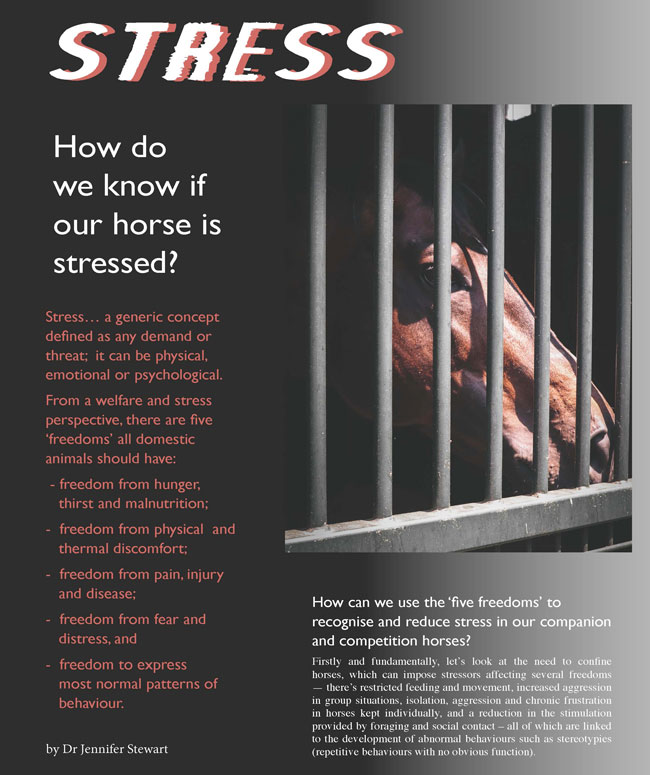
What causes it, how many types are there, how does it
affect horses, how do we know if a horse is stressed?
How can we use the ‘five freedoms’ to recognise and reduce stress in our companion and competition horses?
Firstly and fundamentally, let’s look at the need to confine horses, which can impose stressors affecting several freedoms — there’s restricted feeding and movement, increased aggression in group situations, isolation, aggression and chronic frustration in horses kept individually, and a reduction in the stimulation provided by foraging and social contact – all of which are linked to the development of abnormal behaviours such as stereotypies (repetitive behaviours with no obvious function).
Weaving (a behaviour displayed by some horses in which the horse repetitively sways side to side, shifting its weight and moving its head and neck back and forth) and box walking (repetitive, circular walking or pacing around the sides of a confined area) are associated with locomotor frustration, cribbing and windsucking (repeated swallowing of air) with feeding management frustration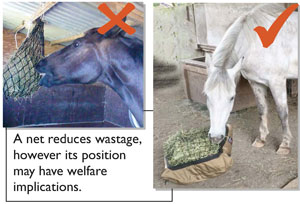 . .
A socially isolated horse is in a chronic state of frustration and weaving can be significantly reduced with access to another horse in an adjacent stable, even if it is only through a small 1m2 portal. Mirrors can help as well by reducing aggressive, threatening behaviour over the stable door.
Stereotypies are quite common in domesticated, stabled horses: 8.3% for crib-biting, 9.5% for weaving and 7.3% for box-walking – however, they are not ever reported in free-roaming horses. It is likely that these behaviours are a highly motivated expression or consequence of distress. Gut motility is decreased below normal and cortisol levels increased beyond normal when horses are simultaneously deprived of both forage access and opportunity to crib-bite.
Providing non-toxic plants, branches and browse while a horse is confined can significantly reduce the stress associated with feeding management frustration. 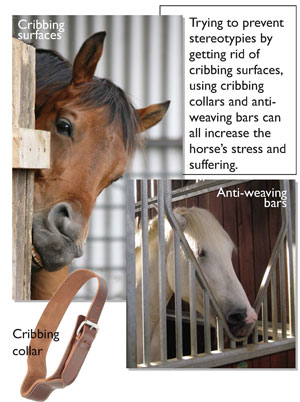
To ensure feeding management is not a source of stress, provide constant access to roughage. However, the way it is fed may have welfare implications. While the use of a net reduces wastage and eases management, the time a horse spends in a head-raised posture is abnormal and can compromise the fine hairs and mucous in its windpipe that sweep up and out any dust and bacteria before they can reach the lungs. Because of the abnormal head position, hay nets that are not positioned very near to, or on the ground, may predispose a horse to a respiratory condition or infection.
Freedom from PHYSICAL AND THERMAL DISCOMFORT
Physical and thermal discomfort considerations bring us to the question of rugging. Clipped and aged horses benefit from rugging, as do those in cold, wet, windy weather. These situations affect the horse’s ability to keep warm. When deciding whether to rug, keep in mind that the thermoneutral zone for adult horses (i.e. the range where shivering and sweating are not needed to regulate temperature) is between minus 15°C and 35°C. For healthy foals, the lower critical temperature is 5C and 28°C for sick foals; for weanlings it’s 0°C.
Hot weather and exercise decrease appetite and place major demands on the horse’s metabolic and cooling systems – increasing core body temperature, sweating, metabolic rate and rate of glucose and fat utilisation. It takes 2-3 weeks for horses to acclimate to changing weather. Increasing oil intake and fine-tuning amino acid balance is beneficial.
Freedom from PAIN, INJURY and DISEASE
Injury and disease are easy enough to recognise! Assessment of pain in horses remains difficult and we often fall short. Recognising early or subtle signs of pain is a challenge. In 1872, Charles Darwin predicted that nonhuman animals could exhibit similar facial expressions in response to emotional states as humans do (Darwin, 1872), but only recently have we had the benefit of research into how this can help us recognise and reduce stress in our horses. The Horse Grimace Scale (HGS) is an effective and practical method of identifying painful conditions. A valuable source of information can be found at: https://www.youtube.com/watch?v=UwoETBDQevc.
CATALOGUE OF BEHAVIOURS
An important milestone in equitation is the development of the ethogram for ridden and un-ridden horses. An ethogram is a species-specific catalogue of all of the observed behaviours of an animal and the social, environmental and other external factors that influence them. For our domestic horses, these external factors include management, training, and riding. The ethogram enables the detection of pain and can easily be used by owners, trainers and vets. A good resource with excellent pictures can be found at https://owlequestrian.ca/2017/12/29/the-ethogram-of-the-ridden-horse-part-1-introduction/.
If we are slow to notice physical problems that affect performance, we may label a horse ‘naughty’.
The possibility that the horse is stressed because of pain somewhere must always be considered.
A recent survey of over 500 sport horses in normal work and presumed to be sound, found 47% were clearly lame. Early recognition of pain is an opportunity for early diagnosis and treatment, and can prevent problems progressing to the stage where the horse is experiencing reduced welfare or a potentially dangerous situation occurs for the rider. Learning how to identify facial expressions, posture, gait changes and tail positions that indicate pain during riding can greatly reduce the horse’s (and the owner’s) stress. Have a look at this presentation for some valuable tips https://www.youtube.com/watch?v=JKzwPrIShTY
Freedom from FEAR AND DISTRESS
Fear of perceived or actual danger includes behavioural and physiological modifications or fight (attack, menace), flight (hiding, escape) and freeze (passive avoidance). Horses have a tendency to escape from frightening events and situations by flight reactions, which can be dangerous for both horse and handler. Understanding this fear response can greatly reduce the risks associated with human-horse interactions and improve equine welfare at the same time. So again, how can we understand and reduce this form of stress?
Fear, distress and mental discomfort happen when there are two or more competing triggers for separate behaviours.
Although competition and sport horses often have better housing and working conditions, the intensive management of performance horses exposes them to a different range of fears, stresses and problems.
Exercise, training and competition may involve isolating horses from other horses and controlling their locomotion – over-riding their inherent needs for social/physical contact/friends, forage and unrestricted, free movement.
Signs of irritation and frustration can be caused by these competing motivations and result in ‘escape’ behaviours.
If we misunderstand the reason behind such behaviours we might attempt to correct them with suppression or punishment-based approaches. But these methods can cause short or long-term stress, worsen the problem or result in avoidance strategies such as abnormal behaviours. Our inappropriate reactions to fear can lead to a long-term negative emotional state of chronic stress and reduced welfare. Importantly, many serious human injuries occur as a result of unexpected horse fear reactions.
The absence of behavioural indicators of stress does not always mean the horse is not stressed – because like all species, horses can and do develop learned-helplessness, a state of chronic stress.
Various fear tests have been used to determine temperament characteristics in horses: novel object, novel arena, restraint and human fear tests. Stress causes an increase in eye temperature. Infrared thermography (measurement of heat using a hand-held, portable monitor) of eye temperature has recently been found to be helpful in assessing physiological reactions to different fearful events, such as being transported; competing in different environments with novel/unusual stimuli and sounds; being approached by unfamiliar people or undergoing a range of handling and management procedures.
Freedom to EXPRESS NORMAL BEHAVIOUR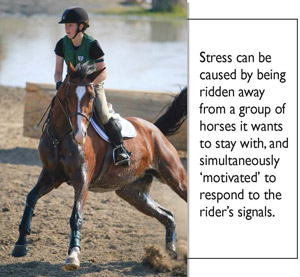
The freedom to express ‘normal’ behaviours is multi-faceted –‘normal’ in a natural sense (found in wild populations); in a statistical sense (common among horses); in a functional sense (i.e. it is adaptive or optimal), and normal in a social sense.
It’s important to appreciate the needs and motivation of behaviour so that our domestic management restricts as little as possible the natural range of behaviours. When it does, the horse can experience environmental deprivation and frustration. For example, paddock or yard size and shape, and bedding type, may affect the time spent lying down or asleep – which predisposes to physical and psychological stress.
Yearling exercise is restricted in paddocks of 1.5ha but not if the area is at least 2.1 ha; square paddocks are preferable to those proportioned 1:2 or 1:4. Bedding also provides horses with one of their main mechanisms for regulating gut acidity. If adequate forage isn’t always available and horses are unable to, or prevented from, engaging in bedding-chewing, they develop compensatory activities such as cribbing and wood-chewing.
Feeding meals of concentrates reduces time spent foraging and chewing (free-range and wild horses chew around 57600 times a day, hand-fed domestic ones around 14,500). This also leads to physical and psychological stress as reduced production of saliva diminishes the natural saliva buffer against gastro-intestinal acidity. Gastric acidity is the number one cause of gastric ulcers and horses with ulcers - regardless of discipline – have elevated blood levels of the stress hormone ACTH – meaning their adrenal glands are over-active.
We need to pause and consider fine-tuning our management to improve well-being rather than assuming that because the horse still functions it can adapt without feeling stress.
Horses are primarily visual communicators and are extremely sensitive to subtle changes in the body language of other horses — and us! They react to tension in humans with the same alarm as when in their mates, and can discriminate between happy and angry photographs of people’s faces. As in dogs, their gaze drifts to the left side and heart rate rises in response to angry faces. Tension related to hyperflexion of the head and neck position also produces a stress response and is associated with increased blood cortisol. Elevated heart rates (18 beats above normal) and abnormal body postures cause stress during transport. This is more important with long journeys and research has shown white blood cell counts, neutrophil to lymphocyte ratios and glucose and cortisol concentrations are higher when horses are cross-tied and lower when horses travel loose – which also benefits respiratory function and reduces the risk of shipping fever. Loading stress usually only occurs in young, unhabituated horses and declines after three successful loadings.
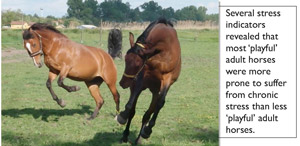
Yawning and playing are puzzling behaviours, and also indicate stress. A large study of domestic horses kept in sub-optimal conditions (meal feeding with limited roughage availability and social isolation) found yawning is triggered by stress and emotional discomfort. Horses showing stereotypic behaviours yawn more than the non-stereotypic horses.
Based on this research, yawning and adult play can both reflect altered welfare states in horses. Other behaviours, like licking, chewing, and head-lowering have long been equated with ‘submission’. However, recently they have been categorised as displacement and self-comforting activities by horses experiencing conflicting motivations, anxiety and adrenalin release.
The combination of magnesium and thiamine has recently been shown in Australian and international studies to reduce ‘speed-reaction tests’ and fear responses as measured by heart rates and cortisol. Because of calming effects in man and mice, tryptophan has been studied in horses. The response is unpredictable. Rather than a sedative effect, oral tryptophan may, under both isolation and visual contact environments, stimulate 2–4 hours after dosing rather than having a sedative effect. And there are breed differences in response with Arabs and Standardbreds showing greater increases in heart rate and walking-sniffing activity after tryptophan administration.
The horse is a strange paradox of strength and acquiescence. It can overcome pain, injury and the instinct for self-preservation, to conform to the rider’s will. This presents those with responsibility for their welfare with profound challenges.
Advances in recognising signs of conflict, distress, fear, and pain in the ridden horse can make equestrian activities safer for everyone involved, primarily the horse and rider.
Thanks to the work of many passionate researchers, in the last 20 years we’ve made huge strides in understanding our horses and finding answers to questions of emotional and psychological stress, health, welfare and well-being.
The works of Australians Paul McGreevy and Andrew MacLean and other researchers around the world have all been published in fantastic books that are worth reading, re-reading and dipping into again and again. Their careers have shone a light on equine behaviour, facial expressions and the development of an equine ethogram (an inventory of normal behaviours) — all of which can help provide understanding and answers.
Some equine responses to stress are characteristic and common to all horses – others are very individual – so knowing your horse well is important, and there are lots of good resources to help you read your horse’s body language.
ABOUT THE AUTHOR
Dr Jennifer Stewart BVSc BSc PhD MRCVS Dip BEP AAIM
Equine Veterinarian and Consultant Nutritionist
An equine veterinarian with over thirty five years’ experience, Jennifer is also a consultant nutritionist and has formulated feeds, custom mixes and supplements for leading international horse feed manufacturers in Australia, India, Ireland, Japan, New Zealand, Philippines, South Africa, Thailand, Turkey and the UAE. Dr Stewart is passionate about equine nutrition and its role in the management, treatment and prevention of many equine disease and she is committed to bringing ‘science to the feed bin’.
For more information visit web: www.jenquine.com |
|
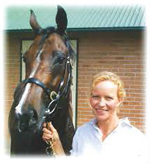 |
|